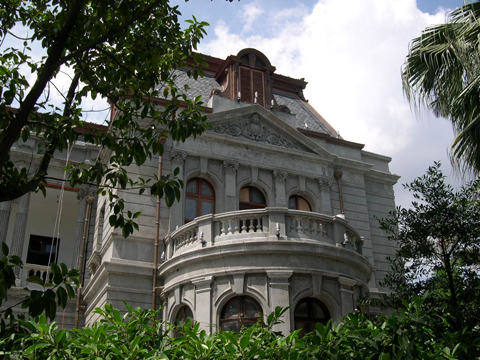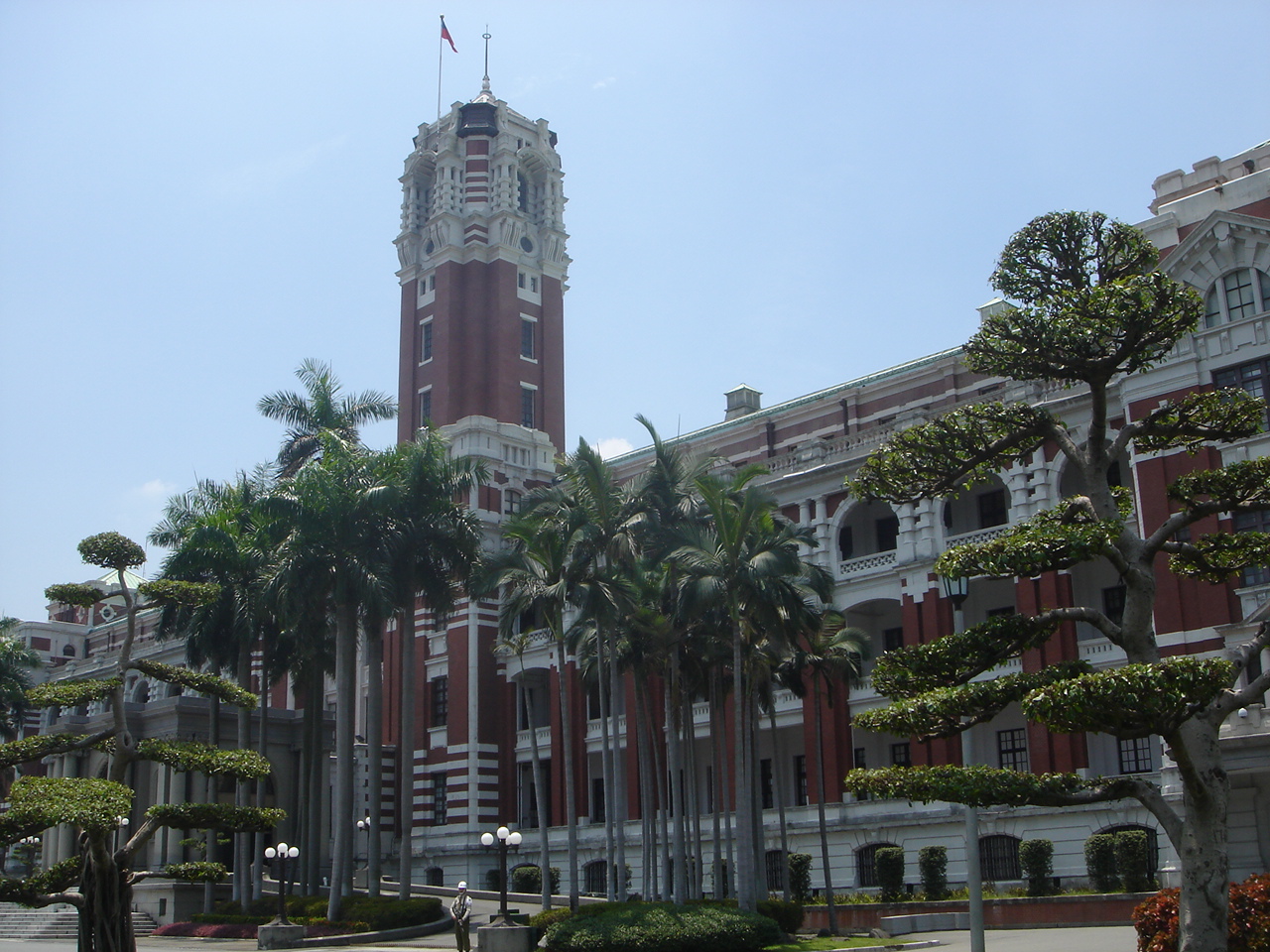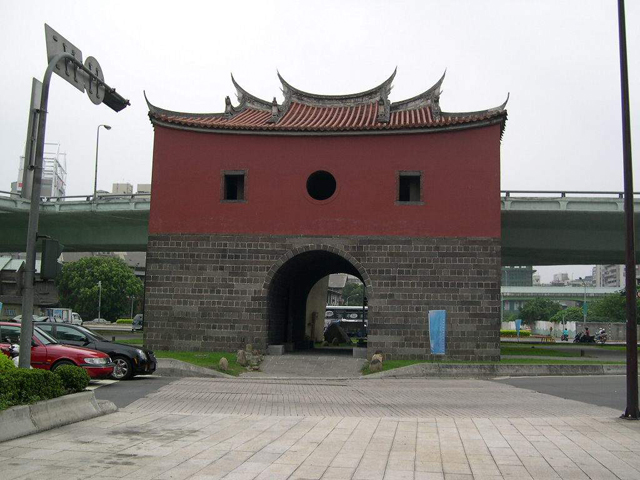Located on Yanping South Road in Zhongzheng District, the Futai Street Mansion is one of the oldest buildings in Taipei City. It was built in 1910 during the Japanese colonial period, and at the time was the only two-story Western-style store building in the city.
The first floor was made of stone, its delicate arcade easily noticeable by passers-by. The second floor was originally made of wood, its roof of copper. The dormer windows on its sloping roof allowed excellent ventilation.
The mansion was declared a historical site in 1997 by the Taipei City Government. In 2002, a fire destroyed the second story, and the Department of Cultural Affairs, Taipei City Government soon launched a renovation of the mansion. It is now open to the public from 10 a.m. to 5 p.m. from Tuesday to Sunday.
Taipei Guest House
The Taipei Guest House is a large two-story European-style compound located at No.1 Ketagelan Boulevard, in the Zhongzheng District, and managed by the Ministry of Foreign Affairs. Designed by Japanese architects Dougo Hukuda and Ichiro Nomura during the Japanese colonial period, its construction started in 1899 and finished in 1901. Serious termite problems led to a major restoration project in 1912, and to a radical change in its external appearance. It was rebuilt by Matsunosuke Moriyama.
The guest house project was initiated by Governor General Kodama Kentarou, and the house remained in use until the last Japanese governor general left Taiwan. The Taipei Guest House has been the venue for many important events in Taiwanese politics and has played an integral role in Taiwan’s modern history.
The two-story U-shaped structure is oriented along an east-west axis. On the first floor, there is a reception room in the east wing and a banquet hall in the west. The second floor is also used for receiving visitors. On the west end, a Japanese-style house was built in 1920 and used as the daily residence for Japanese governors.
A Japanese-style garden, foot bridges, man-made hills, and western-style pavilions give it a peaceful and tranquil atmosphere. Although the building was considered the governor's official residence, the guest house was used to receive important visitors and hold meetings and banquets. It served as the venue for the signing of the Treaty of Taipei in 1952.
Today, it is still used to entertain visiting dignitaries, and for meetings between Taiwanese government officials and those of other countries. It is the largest official guest house in Taiwan.

Office of the President
Formerly known as the Governor-General's Office and headquarters to the Japanese colonial administration in Taiwan, the Office of the President was first designed after a prolonged competition that was held in two stages in 1906 and 1910. Construction began in 1912 and by 1915 a beam-raising ceremony was held to commemorate the completion of the main structure. Finally, in March 1919, the Governor-General's Office was finished.
The 130 meter-wide facade faces east down multi-lane Ketagalan Boulevard. This reflected the style of its Japanese architects, who often oriented important structures at the head of long avenues toward the rising sun.
The architectural design of Uheiji Nagano was selected in 1910. The design was typical of Japanese architects who usually blended in Renaissance, Baroque and neo-Classical features. Plans were submitted to Tokyo where revisions were made to Nagano's original design. Tokyo authorities increased the height of the initial six-story central tower to 11 stories and made defensive improvements to the defense tower and corner towers.
Construction began in June 1912 and was completed in March 1919 at a cost of 2.8 million Japanese yen. The total floor area surpassed more than 10,000 pings, making the Office of the President one of the largest buildings in Southeast Asia at that time.
The building's British-style brick construction, colonnades, gables, vaulted windows, oeil-de-boeuf windows, brackets, Roman columns and composite columns reflect classic European elements common during the Japanese colonial period. The building's Doric-style pillars and the clean and exquisite carvings adorning the exterior walls create a splendid outer appearance. Inside the Presidential Office Building, there are offices, a main atrium and an auditorium, with the combined columns serving as the dominant feature.
The guard towers were partially damaged by Allied bombings during the Second World War. After they were restored in 1946, the semi-domes were replaced with flat roofs. The four corner towers were also rebuilt to create a pair of symmetrical triangles with the central tower.
The Office of the President was temporarily used as the administrative office for the Executive Yuan in 1950.
This spectacular building serves as an important landmark of Taipei City and an emblem of Taiwan’s history over the past 100 years.

The North Gate
The North Gate, a Class 1 historical site dating from 1884, is situated at the intersection of Zhongxiao West Road, Boai Road, Yanping North Road, and Zhonghua Road. The North Gate is one of the four remaining gates that were once part of the Taipei City wall, and the only one that is preserved in its original form. The North Gate has remained unchanged for more than a century as the city has prospered and grown.
In 1879, Taipei district magistrate Chen Xingju ordered the construction of fortifications around the city of Taipei. The project was abandoned after it was discovered that the soil of the proposed site was too loose to support the ambitious construction. A second attempt was made in 1882 by the governor of Fujian Cen Yuying and Taiwan magistrate Liu Ao. Completed in 1884, the wall was nearly five kilometers long and could be accessed by five gates: two on the south side (a main and secondary gate) and one each on the east, west, and north sides. The North Gate, also known as Cheng En Gate, opened to a main road leading to Dadaocheng (in the present-day Datong District of Taipei).
The North Gate rises two stories high and is built with thick enclosed walls punctured by round lookout windows on the second level. The central archway is narrow on the outside face and square in the middle, allowing the gate doors to open inward. The plaque above the archway is inscribed with the characters "Cheng En Men" (meaning “Gate of Upholding Benevolence”). The roof of the gate is single-tiered and upward-curving, giving a soft touch to the solemn structure. The doors of the gate were built first, followed by the walls. The carvings of a lotus and flower vase on the walls of the gate are symbols of peace and safety.
Early in the Japanese colonial era, the city wall and the West Gate were torn down. After Taiwan returned to Chinese rule, the East, South, and Lesser South Gates were completely rebuilt. The North Gate alone retains its original appearance and is the only surviving Qing-dynasty gate in Taipei.


![Taiwan.gov.tw [ open a new window]](/images/egov.png)
